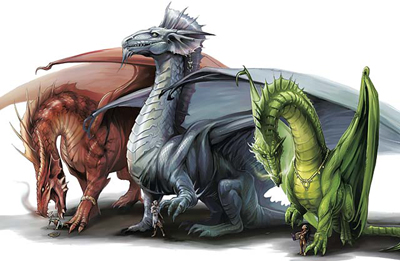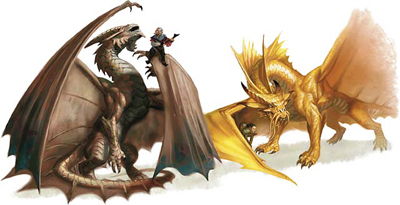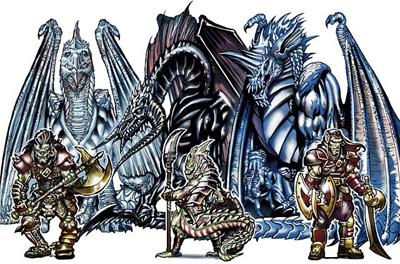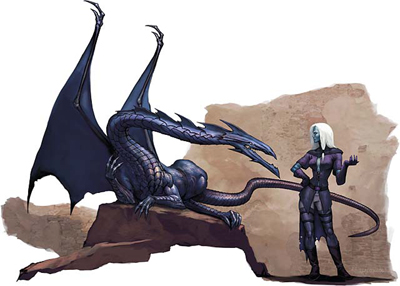SILVERBROW HUMANS

Silver dragons relish humanoid form and enjoy many of the same daily pleasures as humans. Long ago, communities of humans welcomed disguised silver dragons into their villages, not knowing the truth about their new neighbors. In these communities, which were often secluded and small, half-dragon children became common as the dragon visitors married their human friends. The silver progenitors went to great lengths to hide their children from the rest of the world, citing "curses" or "deformities" as an excuse for their physical differences. Despite the occasional discovery, they managed to hide their half-breed offspring long enough to teach them to take humanoid form magically. These children in turn became members of the community, and thus followed generation after generation with the mixed blood of humans and silver dragons.
Over time, the overt draconic physical characteristics faded, leaving human-looking children with silver dragon bloodlines. Eventually, the dragons themselves departed these communities, leaving behind a strong draconic heritage in mostly human descendants. Because they exhibit one of the more common physical signs of draconic heritage - a silver streak or highlights in the hair - they came to be known as silverbrow humans.
Otherwise, silverbrow humans are identical to humans, except as noted below.
-
Dragonblood Subtype: Silverbrow humans are of the dragonblood subtype.
-
Feather Fall (Sp): A silverbrow human can use feather fall once per day, plus one additional time per day for every 5 Hit Dice he has.
-
No Bonus Skill Points: Silverbrow humans don't have the aptitude for learning that standard humans have.
-
Disguise Aptitude: Silverbrow humans have a +2 racial bonus on Disguise checks, and Disguise is always considered a class skill. Their ancestors' need to guard their identities against those who feared or hated them has become second nature to silverbrow humans.
FIREBLOOD DWARVES
All dwarves bore into the earth to make their homes, but few dig as deep as the ancient Fireblood clan. Particularly fond of using dormant volcanoes as the entrances to their homes, these dwarves followed volcanic trails and tunnels in search of greater access to the world's depths. Unfortunately, this led to a horrific encounter with a nest of red dragons. Outraged at the intrusion, the greedy dragons enslaved the entire clan of dwarves. Instead of mining gold and gems for the love of beauty and creation, the dwarves now labored for the dragons.
Over time, the dwarves of the Fireblood clan began to take on certain aspects that differentiated them from others of their kind. No one knows if this was due to interbreeding with dragons, natural mutation, or a magical effect. The result, however, is an offshoot of the dwarf race singularly adapted to high temperatures - and to battling dragonkind.
The Fireblood clan long ago won its freedom, but hatred of red dragons (and by extension, evil dragons in general) still burns in their souls. Descendants of these dwarves intermarried with other dwarf families, spreading the bloodline across many clans. Thus, a modern fireblood dwarf can be born to any dwarf parents.
Fireblood dwarves appear much the same as standard dwarves but have dark, red-brown skin. Most are bald and have only the faintest of beards; their close proximity to the flames deep beneath their volcanic homes tends to burn excess hair away.
Otherwise, fireblood dwarves are identical to dwarves, except as noted below.
-
Dragonblood Subtype: Fireblood dwarves are of the dragonblood subtype.
-
Dragon Dodge: Fireblood dwarves gain a +4 dodge bonus to Armor Class against creatures of the dragon type. In memory of their ancestors, fireblood dwarves train from an early age to avoid surprise attacks from treacherous dragons. Any time a fireblood dwarf loses his Dexterity bonus (if any) to Armor Class, such as when he is caught flat-footed, he loses this dodge bonus, too.
-
Resistance to Fire 5: Fireblood dwarves have an exceptional tolerance for heat and fire, inherited from their enslaved forefathers.
-
Fireblood dwarves do not have the standard dwarf +2 racial bonus on saving throws against poison. The environment of their ancestors was free of such subtle means of attack, so fireblood dwarves are no more resistant to poison than other races.
-
Fireblood dwarves do not have the standard dwarf's +4 dodge bonus to Armor Class against creatures of the giant type.
FORESTLORD ELVES AND HALF-ELVES
Like most sylvan races, elves are in tune with the natural world, and this attunement extends to dragonkind as well. In ancient times, certain elf tribes made pacts with powerful green dragons, which in turn used their magic to imbue the elves with strange new abilities. Though the forestlord elves did not worship these evil dragons, the two groups crafted peace accords that remain in force to this day, long after those who forged the treaties died.
Any descendant of a forestlord elf (including half-elves) can also be a forestlord elf, even if she never agreed to the ancient pacts. However, the forestlord traits are unpredictable, and no one is ever certain if they will manifest in any given elf or half-elf child.
Forestlord elves are easily distinguishable from standard elves by their smooth green skin, similar to the color of a green dragon's scales. Most also have green hair, though it ranges from brown to white on occasion. Otherwise, except as noted below, forestlord elves are identical to elves, and forestlord half-elves are identical to half-elves.
-
Dragonblood Subtype: Forestlord elves and half-elves are of the dragonblood subtype.
-
Treewalk (Su): A forestlord elf or half-elf can transport herself between trees in much the same way that dryads and druids can. Once per day, a forestlord elf can enter a tree by touching it as a move action; once inside the tree, she instantly transports to any other tree within 60 feet. The forestlord elf appears in a square adjacent to the second tree at the beginning of her next turn. When a forestlors elf or half-elf reaches 5 Hit Dice, and for every 5 HD thereafter, she gains one additional use of this ability per day.
-
Class Skills: Hide is a class skill for forestlord elves and half-elves.
-
No bonus on saves against enchantment spells or effects. A costly part of the ancient pacts required the elves to forgo their innate resistance to enchantments.
-
Forestlord elves do not have proficiency with the longsword, rapier, longbow, or shortbow. They spend more time communing with nature and less time practicing with these traditional weapons.
-
Forestlord half-elves have no bonus on Diplomacy or Gather Information checks. Cooperation comes less naturally to these characters.
-
Forestlord Pact: Any forestlord elf or half-elf who attacks or otherwise attempts to harm a green dragon loses her treewalk ability for 24 hours. During that time, the character also takes a -1 penalty on attack rolls, caster level or manifester level, and saving throws.
-
Favored Class: Sorcerer. A multiclass forestlord elf or half-elf's sorcerer class does not count when determining whether she takes an experience point penalty. This class replaces the standard elf's favored class, wizard.
STONEHUNTER GNOMES

One of the few races considered to be fast companions of any kind of drake, stonehunter gnomes are the favored people of copper dragons. Since the coppers' love of pranks, mischief, riddles, and puzzles fits in well with the gnomes' outlook on life, it comes as no surprise that the dragons would associate with the smaller race. The gnomes who return this sentiment are known as stonehunters, a moniker derived from the fact that the two races frequently meet to hunt together. In fact, copper dragons often make their lairs beneath stonehunter gnome villages. Over generations, the gnomes grow more dragonlike in appearance, while the dragons become fonder of the mortals.
Stonehunter gnomes have very dark skin that takes on a coppery sheen in the sunlight. They build their homes in rocky hills, close to the favored environment of their dragon allies, and are renowned for their hunting skills and the extravagance of their parties and celebrations.
Otherwise, stonehunter gnomes are identical to gnomes, except as noted below.
-
Dragonblood Subtype: Stonehunter gnomes are of the dragonblood subtype.
-
Hunter's Insight: As frequent hunting companions of great copper dragons, stonehunter gnomes quickly develop the skills necessary to track down their prey. They have a +2 racial bonus on Climb and Survival checks as a result of their upbringing.
-
Stonehunter gnomes do not have the standard gnome's +2 saving throw bonus against illusions, nor do they add +1 to the Difficulty Class of illusion spells they cast. Stonehunter gnomes care little for illusions and instead spend the majority of their time honing their hunting skills.
-
Favored Class: Ranger. A multiclass stonehunter gnome's ranger class does not count when determining whether he takes an experience point penalty. This class replaces the standard gnome's favored class, bard.
GLIMMERSKIN HALFLINGS
Gold dragons hate injustice and foul play, but few things aggravate them more than the tyranny of the strong over the weak - or the small. When a gold dragon's territory includes or is near a halfling village, the dragon quietly appoints itself the settlement's protector, guarding it from threats too great for the halflings to defeat. Seldom do the villagers learn of the dangers that never come to pass, and even more rarely do they discover the true identity of their guardian.
The dragon often walks among its charges, appearing as a traveler, a harmless animal, or a newly arrived halfling seeking to settle in the village. Though any serious relationships that result are short-lived (from the dragon's point of view), the descendants of such couplings bear signs of draconic heritage for many generations.
Glimmerskin halflings typically have a warm, golden sheen to their complexion, and their eyes inevitably hold metallic flecks of gold. They commonly display traits of nobility and bravery, standing up against threats of any nature.
Otherwise, glimmerskin halflings are identical to halflings, except as noted below.
-
Dragonblood Subtype: Glimmerskin halflings are of the dragonblood subtype.
-
Touch of Luck: Once per day, a glimmerskin halfling can grant himself or any ally within 30 feet a +2 luck bonus on a single saving throw. Using this ability is an immediate action and must be announced before the roll is made.
-
Class Skills: Heal is a class skill for glimmerskin halflings.
-
No Move Silently Bonus: Glimmerskin halflings don't share the standard halfling's penchant for stealth.
VILETOOTH LIZARDFOLK

Many lizardfolk tribes forge alliances with black dragons because they share similar habitats. Over generations, some tribes come to worship these dragons, and this close relationship often results in a mingling of the bloodlines. The legacy of these dragons still lingers today. In some cases, entire tribes share this bloodline, while in other cases, it manifests randomly among standard lizardfolk. Regardless, these individuals are known as viletooth lizardfolk.
Viletooth lizardfolk are thin or even scrawny compared to others of their kind. They always have patches of black scales, and some have hides of pure ebony. Viletooth lizardfolk have large eyes and frequently grow short, curved horns resembling those of their draconic ancestors.
Otherwise, viletooth lizardfolk are identical to lizardfolk, except as noted below.
-
+2 Constitution: A viletooth lizardfolk is less muscular than other lizardfolk but inherits some of a black dragon's cunning. This ability score modifier replaces the standard lizardfolk ability score modifiers.
-
Dragonblood Subtype: Viletooth lizardfolk are of the dragonblood subtype.
-
Acid Bite (Su): A viletooth lizardfolk's bite attack deals 1d6 points of acid damage in addition to its normal damage.
-
Water Breathing (Ex): Viletooth lizardfolk can breathe underwater indefinitely.
-
Class Skills: Move Silently is a class skill for viletooth lizardfolk.
-
No Hold Breath Special Quality: Viletooth lizardfolk don't share the standard lizardfolk's ability to hold its breath longer than normal.
SUNSCORCH HOBGOBLINS
Hobgoblins often ally with powerful dragons, supplying the drake with treasure and sometimes a lair in exchange for assistance in battle. Of all the chromatic dragons, blue dragons are the most common hobgoblin allies. Their territories often overlap, with the hobgoblins settling in hilly or broken lands adjoining deserts controlled by blue dragons, and both races recognize that alliances are more productive than rivalries. Mighty blues often "adopt" a nearby tribe of hobgoblins, while stories tell of tribes that raise wyrmling blue dragons to adulthood over many generations.
Although physical relationships between the two races are unusual, the priests of the Sunscorch tribe of hobgoblins developed divine rituals that allowed them to take on draconic characteristics. The original tribe has long since disappeared, but the traits created by these rituals linger in the hobgoblin race. The birth of a sunscorch hobgoblin is considered a powerful omen, though whether it bodes great fortune or ill tidings depends on how threatened the tribe leaders feel about the new arrival.
Sunscorch hobgoblins appear much like their fellows, except for their brilliant azure eyes. They display exceptional cunning and patience, but often share the vanity of blue dragons. They have a natural love of power; when a sunscorch hobgoblin isn't leading a warband or tribe, he is likely the voice of wisdom behind its leader.
Otherwise, sunscorch hobgoblins are identical to hobgoblins, except as noted below.
-
+2 Constitution, +2 Wisdom: Sunscorch hobgoblins display exceptional insight and share their fellows' toughness, but they aren't as agile as standard hobgoblins. These ability score modifiers replace the standard hobgoblin ability score modifiers.
-
Dragonblood Subtype: Sunscorch hobgoblins are of the dragonblood subtype.
-
Sunscorch hobgoblins have a +2 racial bonus on Bluff checks because of their natural ability to deceive their enemies.
-
Sunscorch hobgoblins are inured to the environmental hazards of the blue dragons' home. They have a +2 racial bonus on Fortitude saves to avoid nonlethal damage from heat.
FROSTBLOOD ORCS AND HALF-ORCS
Hailing from the frigid north and among the most savage of warriors, frostblood orcs trace their origins to barbarian hunters who both revered and hunted white dragons. In ancient times, some primitive orc tribes considered white dragons to be the supreme prey in the brutal frostfell of their homeland, valued highly due to the scarceness of other bounty. When scouts spotted a white dragon, the tribes' fiercest warriors gathered for hunting expeditions that lasted for weeks or months at a time, after which they would return home with the dragon carcass - or wouldn't return at all. Victorious warriors carried out rituals in which they drank the blood of the white dragon they killed, a process that somehow altered their race over generations and imbued them with the essence of the very creatures they hunted. Some half-orcs also display these traits.
Modern frostblood orcs still hail from the north but have since joined the rest of civilization, if only as outlanders. They have pale white skin and catlike eyes, with stringy white or gray hair that grows quickly.
Otherwise, except as noted below, frostblood orcs are identical to orcs, and frostblood half-orcs are identical to half-orcs.
-
Dragonblood Subtype: Frostblood orcs and half-orcs are of the dragonblood subtype.
-
Resistance to Cold 10: Because their ancestors ingested the blood of great white dragons, all frostblood orcs and half-orcs are naturally resistant to damage from cold-based attacks.
-
Endurance: Frostblood orcs and half-orcs have Endurance as a bonus feat. If a frostblood orc or half-orc would later gain Endurance as a bonus feat, he can select any other feat for which he qualifies.
-
Vulnerability to Fire: Frostblood orcs and half-orcs share the white dragon's vulnerability to fire-based attacks.
DEEPWYRM DROW AND HALF-DROW OF FAERUN

Deep dragons are among the most dangerous hunters in the Underdark. Thanks to their ability to assume humanoid form, they frequently interact with other denizens of these shadowy tunnels while posing as drow. In this guise, deep dragons explore dark elf communities and forge powerful alliances, often without the drow realizing the truth about their new partners.
In some cases, these relationships produce half-dragon offspring, and these bloodlines have a way of manifesting themselves in later generations as deepwyrm drow. Such drow are typically sinuous in build, with skin that has maroon or purple highlights.
Otherwise, except as noted below, deepwyrm drow are identical to drow, and deepwyrm half-drow are identical to half-drow.
-
Dragonblood Subtype: Deepwyrm drow and half-drow are of the dragonblood subtype.
-
Spell-Like Abilities : 3/day - detect magic; 1/day - disguise self. The caster level for these effects is equal to the character level of the deepwyrm drow or half-drow.
-
Deepwyrm drow lose the power to use faerie fire as a spell-like ability.
-
Deepwyrm drow and half-drow gain a +2 racial bonus on Bluff checks.
-
Deepwyrm half-drow lose the standard +2 racial bonus on Diplomacy checks.
-
Deepwyrm drow and half-drow lose the standard +2 racial bonus on Will saves against spells and spell-like abilities.